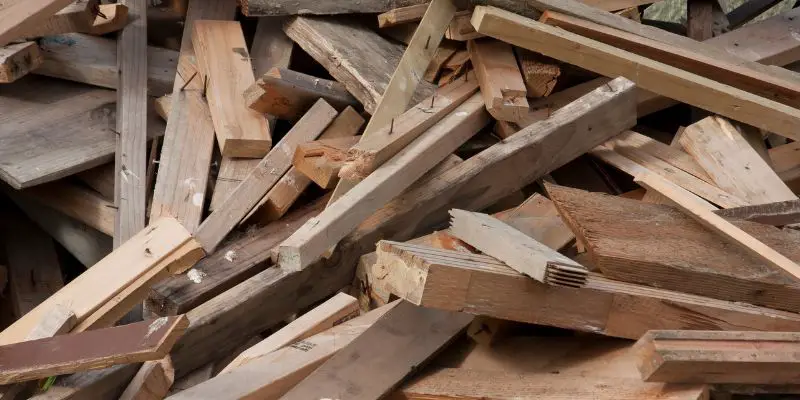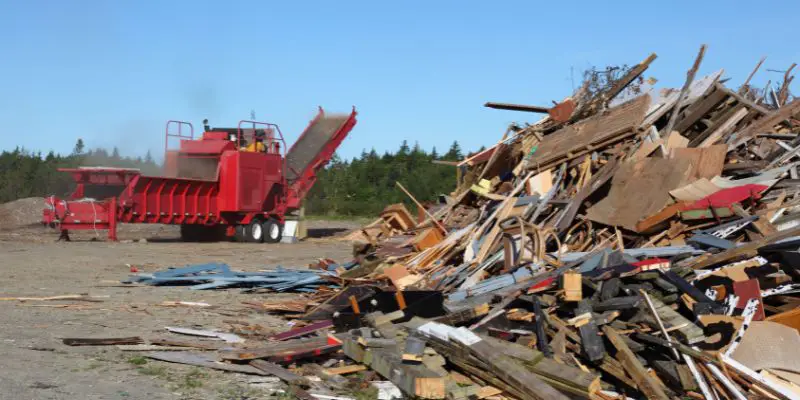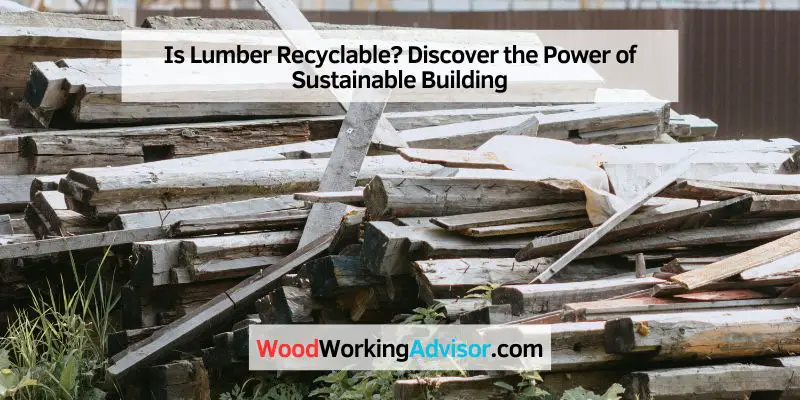Yes, lumber is recyclable, making it an environmentally friendly material. Lumber can be reused or repurposed for various applications, reducing the need for new resources and minimizing waste in landfills.
Lumber, also known as timber, is an essential material used in construction, woodworking, and other industries. It is derived from trees and is typically used to create structures, furniture, and various wood products. While the primary use of lumber is for its intended purpose, it is important to consider the environmental impact of its disposal.
Recycling lumber helps to minimize waste, conserve resources, and reduce deforestation. By reusing or repurposing lumber, we can extend its lifecycle and contribute to a more sustainable and eco-friendly approach. We will explore the recyclability of lumber and the benefits it offers to the environment.
The Sustainability Of Lumber
When it comes to sustainable building materials, lumber is often considered a top choice for many construction projects. But have you ever wondered if lumber is recyclable? In this article, we will explore the recyclability of lumber and the benefits of using recycled lumber in construction.
Recycling Lumber
Recycling lumber is a key component of sustainable construction practices. Wood can be recycled multiple times without losing its structural integrity, making it an environmentally friendly choice. When old structures are demolished or when wood waste is produced during manufacturing, this wood can be repurposed and used again in new construction projects.
How is lumber recycled?
During the recycling process, old wood is sorted and inspected to determine its usability. Reusable lumber is then cleaned, processed, and graded based on its quality. Some recycled lumber may require additional treatment to remove any contaminants or insect infestations. Once properly prepared, the recycled lumber is then ready to be used in various applications, ranging from furniture making to building new structures.
Benefits Of Using Recycled Lumber
There are several notable benefits to using recycled lumber in construction projects:
- Sustainability: Using recycled lumber helps to conserve natural resources and reduce deforestation. By giving new life to old wood, the demand for fresh timber is reduced, leading to less strain on forests.
- Energy efficiency: Recycling lumber requires less energy compared to the production of new wood products. This results in a smaller carbon footprint and helps to combat climate change.
- Cost-effectiveness: Recycled lumber is often more cost-effective compared to new wood products. By utilizing reclaimed wood, builders can achieve their sustainability goals while also staying within budget.
Is recycled lumber as durable as new lumber?
Yes, recycled lumber can be just as durable as new lumber, especially when it undergoes proper processing and grading. By ensuring that the recycled wood meets industry standards, builders can confidently use it without compromising structural integrity or longevity.
In conclusion, recycling lumber not only helps to reduce waste and conserve natural resources, but it also offers numerous benefits in terms of sustainability, energy efficiency, and cost-effectiveness. So, if you’re looking to embark on an eco-friendly construction project, consider using recycled lumber for a truly sustainable building solution.

Challenges In Lumber Recycling
Lumber recycling presents challenges due to the presence of contaminants such as paint, coatings, and adhesives, negatively impacting the quality of recycled lumber. This hinders the process and increases costs, making it important to address these issues for effective lumber recycling.
Contamination Issues
Lumber recycling faces a significant challenge when it comes to contamination. Due to the diverse applications of wood, it often ends up being contaminated with various substances such as paints, coatings, adhesives, and preservatives. This contamination poses a major problem as it hinders the recycling process and limits the quality of the recycled lumber obtained.
Contamination can occur at several stages, starting from the initial use of wood in construction or manufacturing projects. As these projects often involve the use of chemicals that make the wood unsuitable for recycling. For instance, paints and coatings can contain harmful substances like lead, which can leach into the environment if not properly handled during recycling.
The presence of adhesives and preservatives in wood can also impede the recycling process. Adhesives like glue can reduce the quality of the recycled lumber, making it less suitable for certain applications. Preservatives like pressure-treated wood contain hazardous chemicals that can pose health risks if released into the environment during the recycling process.
Technological Barriers
Aside from contamination issues, lumber recycling also faces technological barriers that complicate the process. Recovering high-quality lumber from mixed waste materials proves to be a complex task. The lack of advanced separation technologies or automated systems designed specifically for wood recycling poses challenges for the industry.
Wood often gets mixed with other materials in waste streams, such as plastic, metal, or concrete. This mixture makes sorting and separating the wood from other materials difficult, leading to increased costs and inefficiencies in the recycling process. Moreover, the different sizes and shapes of wood waste pose challenges for automated sorting equipment that may not be able to accurately distinguish between suitable and unsuitable materials.
Furthermore, the current recycling technologies might not be capable of handling all types of wood waste efficiently. Some wood products, like engineered wood, contain glues and resins that can be challenging to break down and recycle effectively.
To overcome these technological barriers, research and development efforts are underway to enhance sorting methods and improve the efficiency of wood recycling technologies. By developing advanced separation techniques and refining the recycling processes, the industry aims to achieve better quality recycled lumber and reduce the environmental impact associated with wood waste disposal.
In conclusion, the challenges of contamination and technological barriers pose significant hurdles for lumber recycling. Addressing these issues requires collaboration between the construction and manufacturing industries, regulatory bodies, and recycling facilities to develop effective strategies that promote a more sustainable approach to wood waste management.
Innovative Solutions
When it comes to the issue of recycling lumber, innovative solutions have been instrumental in addressing this environmental concern. Advanced sorting methods and new processing techniques have played a pivotal role in enhancing the recyclability of lumber, and promoting sustainability in the construction and manufacturing industries.
Advanced Sorting Methods
Advanced sorting methods leverage technology to effectively separate different types of lumber, facilitating the recycling process. Through the use of automated sorting systems and machine learning algorithms, lumber can be sorted based on its size, quality, and composition. This not only streamlines the recycling process but also ensures that each type of lumber is utilized in the most efficient manner.
New Processing Techniques
New processing techniques have revolutionized how lumber is recycled, providing more efficient and effective methods for reusing this valuable resource. Innovations such as high-speed chipping and precision milling have enabled the transformation of recycled lumber into high-quality materials for various applications. Additionally, the implementation of sustainable practices in the processing of recycled lumber has further enhanced its eco-friendly characteristics.
Environmental Impact
One of the key considerations when assessing the sustainability of any material is its environmental impact. In the case of lumber, understanding the effects on deforestation, energy usage, and carbon emissions is crucial. Let’s take a closer look at how the recycling of lumber positively contributes to reducing deforestation and minimizing energy and carbon footprint.
Reduction In Deforestation
Lumber recycling plays a significant role in reducing deforestation, which is the process of clearing forests for timber or converting land into non-forest use. By reusing and repurposing old or discarded lumber, we can limit the demand for freshly cut trees. This reduction in deforestation has several important benefits:
- Preservation of Ecosystems: Forests are home to a vast array of plant and animal species. By recycling lumber, we help protect these ecosystems from being disrupted or destroyed, allowing them to continue providing habitat and supporting biodiversity.
- Conservation of Natural Resources: Trees are a valuable and renewable resource. By salvaging lumber, we extend the lifespan and usability of existing wood and minimize the need to extract new resources from forests.
- Prevention of Soil Erosion: Deforestation can lead to increased soil erosion, negatively impacting the fertility and stability of land. By recycling lumber, we contribute to preserving soil quality and preventing erosion.
Energy And Carbon Footprint
The energy and carbon footprint associated with lumber production can be significant. Recycling lumber offers several environmental benefits by minimizing the energy consumption and carbon emissions traditionally associated with the lumber industry. Here’s how:
- Energy Savings: Repurposing lumber requires less energy compared to the extraction, processing, and transportation of new timber. By recycling, we reduce the overall energy demand and promote more sustainable practices.
- Reduced Carbon Emissions: The process of cutting, transporting, and manufacturing new timber contributes to carbon emissions. By using recycled lumber, we decrease the amount of carbon released into the atmosphere, thus helping mitigate climate change.
- Landfill Diversion: When lumber is disposed of in landfills, it not only takes up valuable space but also contributes to the release of methane, a potent greenhouse gas. By recycling lumber, we divert waste from landfills and mitigate methane emissions.
The recycling of lumber offers a straightforward and effective way to reduce the environmental impact associated with deforestation, energy consumption, and carbon emissions. By opting for recycled lumber, we can make a positive contribution towards a greener, healthier planet.
Future Of Lumber Recycling
The future of lumber recycling is promising, as the need for sustainable practices and reduced environmental impact continues to grow. With the increasing emphasis on circular economy and waste reduction, the lumber industry is increasingly focusing on implementing recycling practices. In this section, we will explore market trends and policy and regulation that will shape the future of lumber recycling.
Market Trends
The market for recycled lumber is gaining traction due to several factors. Firstly, the growing awareness of the ecological impact of deforestation and the depletion of natural resources has led consumers and businesses to seek sustainable alternatives. Recycled lumber fits this demand perfectly, offering a viable solution for reducing the environmental footprint of construction projects.
Moreover, the rise in green building practices has further boosted the demand for recycled lumber. Builders and architects are increasingly incorporating sustainable materials into their designs, and recycled lumber provides an attractive option that meets their requirements.
The market for recycled lumber is also driven by the growing popularity of reclaimed wood. Reclaimed wood carries a unique aesthetic appeal, creating a rustic and vintage look that many consumers and designers appreciate. This demand for reclaimed wood adds even more value to the recycled lumber market, as it encourages the salvage and reuse of old wood.
Policy And Regulation
The future of lumber recycling is not solely reliant on market trends but also on robust policy and regulation. Governments and environmental agencies are recognizing the need to address the challenges posed by excessive deforestation and waste generation in the lumber industry.
Regulations aimed at encouraging and enforcing sustainable practices in the lumber industry are being implemented around the world. These regulations create a framework that promotes the recycling of lumber and ensures that it meets certain quality standards. They also encourage the responsible disposal of wood waste, reducing the amount of material that ends up in landfills.
Policy initiatives are also playing a crucial role in driving the future of lumber recycling. Many countries are offering incentives and subsidies to businesses and individuals who adopt sustainable materials and recycling practices. These initiatives are not only beneficial for the environment but also provide economic advantages, creating a win-win situation for all stakeholders involved.
In conclusion, the future of lumber recycling looks bright. The combination of market trends that favor sustainable practices and the adoption of robust policy and regulation provides a solid foundation for the growth of the industry. As more individuals and businesses recognize the importance of reducing waste and embracing circular economy principles, the demand for recycled lumber will continue to rise, driving innovation and further development in this field.

Frequently Asked Questions Of Is Lumber Recyclable
Can I Put Wood In My Recycling Bin?
No, wood cannot be put in your recycling bin. Wood is not typically accepted in recycling programs as it can contaminate other recyclables. Instead, consider reusing or repurposing the wood or check if there are any local options for wood recycling or disposal.
Where Can I Dispose Of Wood In Austin?
You can dispose of wood in Austin at the Austin Wood Recycling Facility. It accepts all types of wood waste, including lumber, pallets, and branches. Proper disposal helps to reduce waste and protect the environment.
What Wood Can Be Recycled?
Most types of wood can be recycled, including hardwoods like oak and maple, softwoods like pine and cedar, and engineered woods like plywood and particleboard. Recycling wood helps to reduce waste and conserve natural resources.
Why Is Wood Hard To Recycle?
Wood is difficult to recycle because it can be contaminated by paint, glue, or other materials. Additionally, it is bulky and hard to break down into usable pieces. Sorting and processing wood waste also requires specialized equipment and can be costly.
Conclusion
Lumber is recyclable, contributing to a sustainable environment. By reusing and repurposing wood, we can reduce waste and lower our carbon footprint. It’s important to consider the environmental impact of lumber and make informed choices. Let’s continue to prioritize eco-friendly practices and promote a greener future.


